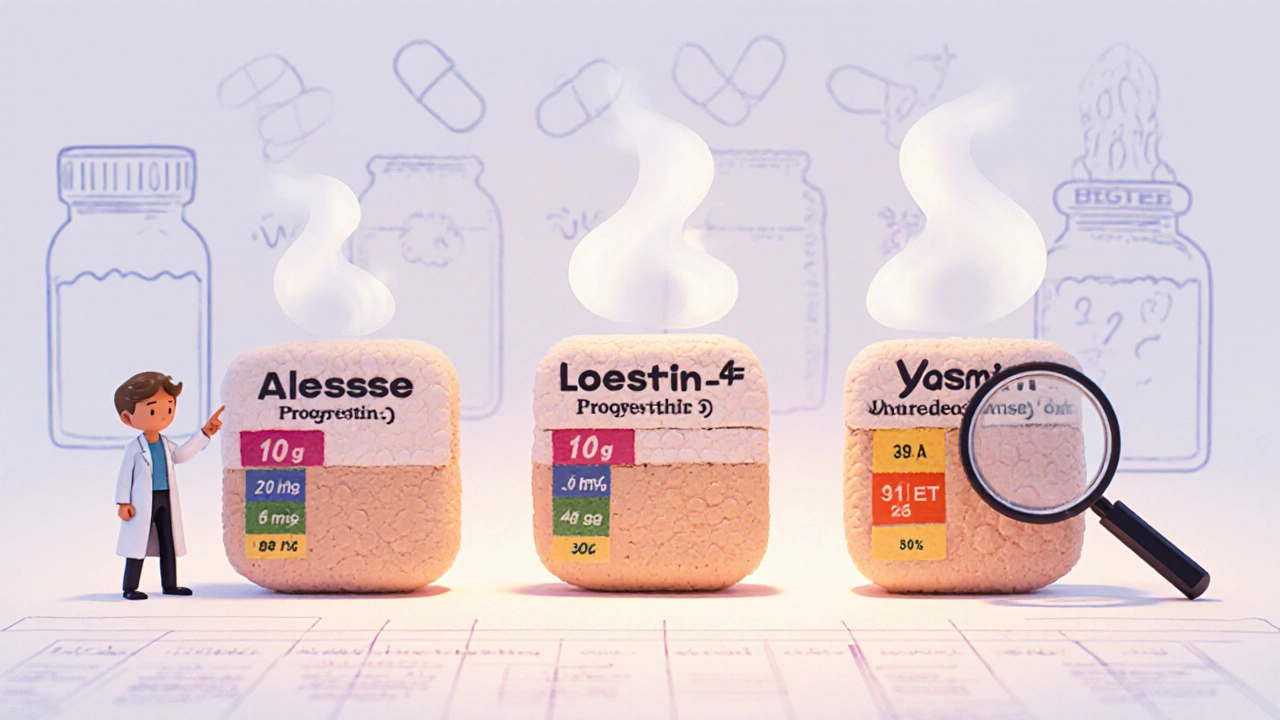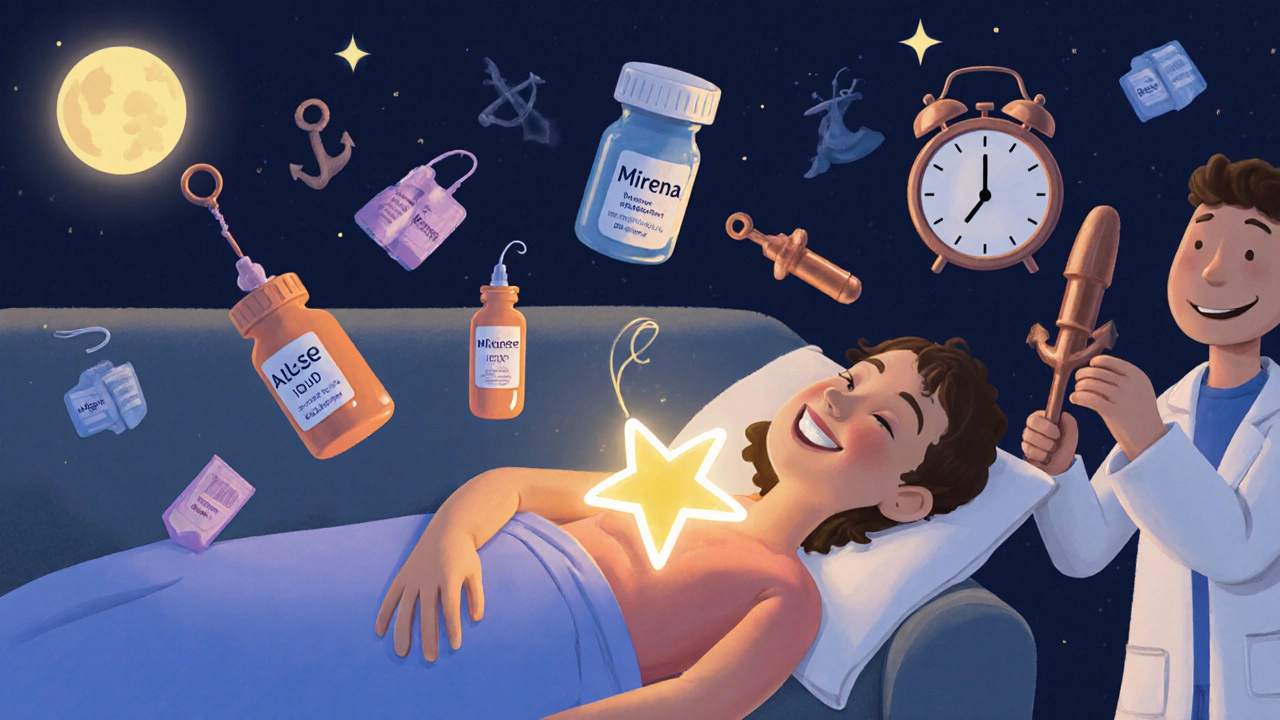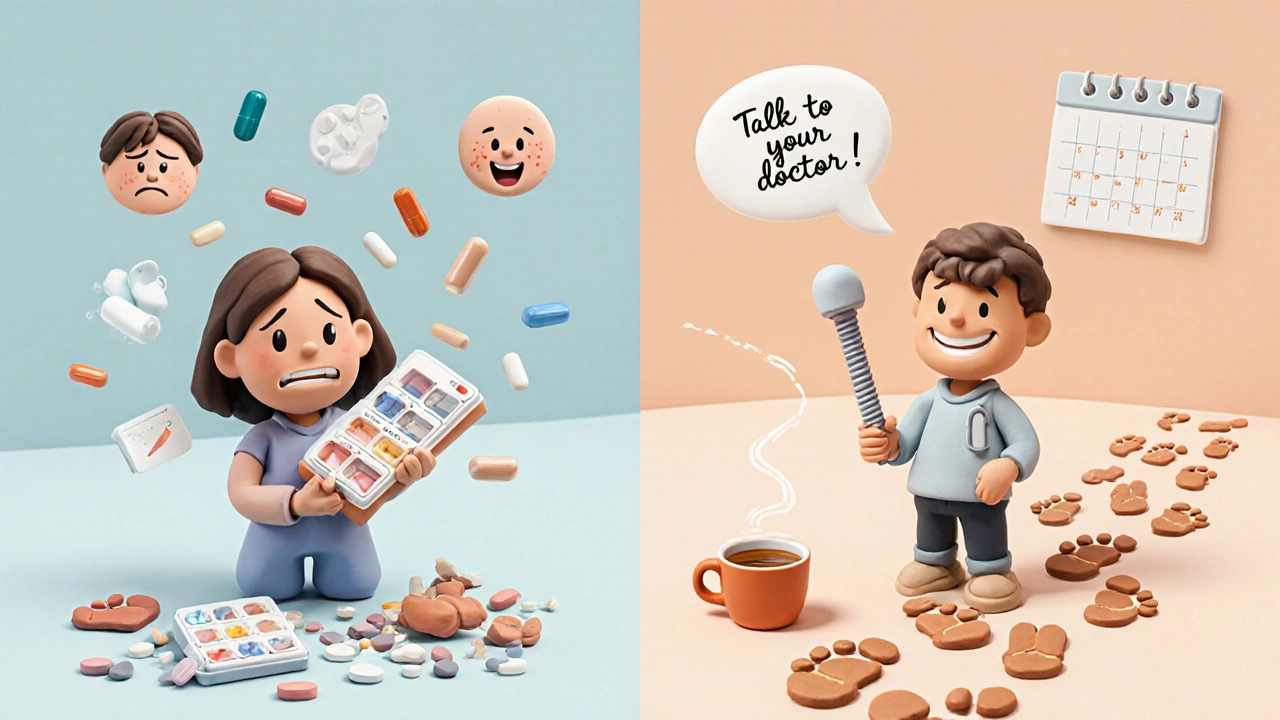Compare Alesse (Ethinyl Estradiol, Levonorgestrel) with Alternatives

Oct, 27 2025
Birth Control Option Selector
Select your key priorities to see which birth control options match your needs.
Recommended Options
If you're taking Alesse or thinking about it, you're probably weighing your options. Alesse contains ethinyl estradiol and levonorgestrel - two hormones that stop ovulation and thicken cervical mucus to prevent pregnancy. But it’s not the only pill out there. Many people switch because of side effects, cost, or just wanting something that fits their body better. So what else is out there? And how do you know if another pill might work better for you?
What’s in Alesse?
Alesse is a combination birth control pill. Each active tablet has 0.02 mg of ethinyl estradiol and 0.1 mg of levonorgestrel. That’s a low dose - especially compared to older pills from the 1970s, which had up to 10 times more estrogen. The low dose helps reduce side effects like nausea or breast tenderness, but it doesn’t eliminate them. About 1 in 5 people stop taking Alesse in the first year because of spotting, mood changes, or headaches.
It’s a 21-day pill: you take one daily for three weeks, then skip a week. Your period comes during that break. Some people like the predictability. Others hate the hormone-free week because it brings back symptoms they thought were gone.
How Alesse Compares to Other Combination Pills
There are dozens of combination pills on the market. Most have ethinyl estradiol and a progestin, but the doses and types of progestin vary. That’s where the real differences show up.
Here’s how Alesse stacks up against three common alternatives:
| Pill Name | Ethinyl Estradiol Dose | Progestin Type | Progestin Dose | Typical Use Failure Rate | Common Side Effects |
|---|---|---|---|---|---|
| Alesse | 0.02 mg | Levonorgestrel | 0.1 mg | 7% | Spotting, headaches, breast tenderness |
| Loestrin 24 Fe | 0.02 mg | Norethindrone acetate | 1 mg | 7% | Less spotting, mild bloating |
| Yasmin | 0.03 mg | Drospirenone | 3 mg | 7% | Acne improvement, lower water retention |
| Ortho Tri-Cyclen | 0.035 mg | Norgestimate | 0.18-0.25 mg (multi-phase) | 7% | Mood swings, weight gain |
Loestrin 24 Fe has the same estrogen dose as Alesse but uses norethindrone acetate instead of levonorgestrel. Many users report fewer breakthrough bleeds because of the 24-day active pill phase. Yasmin contains drospirenone, which acts like a natural diuretic. That helps with bloating and acne - common complaints with Alesse. But drospirenone can raise potassium levels, so it’s not safe for people with kidney, liver, or adrenal problems.
Ortho Tri-Cyclen is a triphasic pill. The hormone dose changes over the cycle. Some women like the variation because it mimics natural hormone swings. Others find it harder to remember which pill to take when. The slightly higher estrogen dose (0.035 mg) can increase the risk of blood clots - just a bit - compared to Alesse.
What About Progestin-Only Pills?
If you can’t take estrogen - maybe you’re over 35 and smoke, have migraines with aura, or had a blood clot - then progestin-only pills (POPs) are an option. These are often called the “mini-pill.”
Popular brands include Camila, Errin, and Jolivette. They contain only norethindrone, usually at 0.35 mg daily. No estrogen means no increased risk of clots or stroke. But they’re trickier to use. You have to take them at the same time every day, within a 3-hour window. Miss it by a few hours, and your protection drops fast.
Side effects? Irregular bleeding is the big one. Some people get lighter periods. Others get constant spotting. Weight gain and acne are less common than with combination pills, but mood changes still happen. If you’re okay with the strict timing and can handle unpredictable bleeding, POPs are a solid alternative.

Other Birth Control Options Beyond Pills
Why limit yourself to pills? There are more effective, lower-maintenance options now.
- Implants (Nexplanon): A tiny rod placed under your arm that releases etonogestrel for up to 3 years. Over 99% effective. Bleeding patterns change - some get no periods, others get constant spotting. No daily pills to remember.
- IUDs: Two types. Hormonal IUDs like Mirena or Kyleena release levonorgestrel directly into the uterus. They last 5-8 years. Most users get lighter or no periods. Copper IUDs (Paragard) have no hormones at all. They last 10 years and are the most effective non-hormonal option.
- Injection (Depo-Provera): A shot every 3 months. High effectiveness, but can cause weight gain and bone thinning with long-term use. Not ideal if you plan to get pregnant soon.
These methods have lower failure rates than pills. Even if you forget to take your pill, an IUD or implant keeps working. That’s why experts recommend them as first-line choices for most people.
When to Consider Switching from Alesse
You don’t need to stick with Alesse just because it worked once. Here are signs it might be time to try something else:
- You’ve had persistent headaches, especially with vision changes or dizziness.
- You’re gaining weight despite no lifestyle changes.
- You’re getting acne instead of less of it.
- Your periods are heavier or more painful than before.
- You’re tired of taking a pill every day.
If any of these sound familiar, talk to your doctor. Don’t just quit cold turkey. Stopping suddenly can cause hormonal crashes - heavy bleeding, mood swings, or even ovulation right away. Your doctor can help you taper or switch safely.

Cost and Insurance: What You Should Know
Alesse is available as a generic, which keeps the price low. In Australia, with a PBS subsidy, it costs about $30 for a 3-month supply. Without subsidy, it’s around $100. But many alternatives cost less.
Generic versions of Loestrin 24 Fe or Yasmin often run $20-$40 for three months. IUDs and implants cost more upfront - $800-$1,200 - but they last years. When you spread that cost out, they’re cheaper than pills over time. Most private insurance plans cover them fully under preventive care laws.
If cost is a barrier, ask your pharmacy about patient assistance programs. Many drug makers offer free or discounted pills for people with low income.
What Works Best for Different People
There’s no one-size-fits-all. Your best option depends on your body, your lifestyle, and your goals.
- If you want minimal side effects and low estrogen: Loestrin 24 Fe is a good swap. Less spotting than Alesse for many users.
- If you struggle with acne or bloating: Try Yasmin. Drospirenone helps with both.
- If you hate daily pills: Go for an IUD or implant. You won’t think about it again for years.
- If you can’t take estrogen: Progestin-only pills or the copper IUD are your safest bets.
- If you’re trying to avoid periods: Extended-cycle pills like Seasonique or the hormonal IUD can reduce or eliminate monthly bleeding.
Studies from the CDC show that people who switch to a method that fits their life are far more likely to keep using it. That’s the real goal - not just finding a pill, but finding a system that works for you long-term.
Final Thoughts
Alesse is a safe, well-studied pill. But it’s not the only one - and it’s not the best for everyone. The right birth control isn’t the one with the lowest price or the most ads. It’s the one you can stick with. If you’re unhappy with Alesse, don’t assume it’s you. It might just be the wrong match.
Talk to your doctor. Bring a list of what you like and don’t like. Ask about alternatives. Try one for a few months. Your body will tell you what it needs.
Is Alesse the same as Levora?
Yes, Alesse and Levora are essentially the same. Both contain 0.02 mg ethinyl estradiol and 0.1 mg levonorgestrel. They’re generic versions of the same brand-name pill. The only differences are the manufacturer and pill color. You can switch between them without any change in effectiveness or side effects.
Can Alesse cause weight gain?
Some people gain a few pounds on Alesse, but studies show it’s usually water retention, not fat. In controlled trials, women on Alesse gained an average of 1-2 kg over a year - similar to those on a placebo. If you notice significant weight gain, it might be due to diet, stress, or another hormone issue. Talk to your doctor before assuming it’s the pill.
Is Alesse good for acne?
Alesse is not FDA-approved for acne treatment. Some users report clearer skin, but others get breakouts. Pills with drospirenone (like Yasmin) or norgestimate (like Ortho Tri-Cyclen) are more consistently effective for acne. If acne is your main concern, ask about those instead.
What happens if I miss a pill on Alesse?
If you miss one pill, take it as soon as you remember, even if that means taking two in one day. If you miss two or more pills in a row, use backup contraception (like condoms) for the next 7 days. You might also get spotting or an early period. If you’re unsure, use an emergency contraceptive like levonorgestrel pills - they’re available over the counter in Australia.
Can I switch from Alesse to an IUD?
Yes, you can switch directly from Alesse to an IUD. Your doctor will typically insert the IUD during your hormone-free week. You’ll be protected immediately. No need to wait or use backup contraception. This is a common and safe transition. Many people find the IUD easier to manage long-term.
